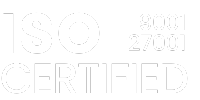The methodology of an LCA is defined in ISO 14040. But the family of standards defined in ISO 14000 ff sets standards for many more aspects of the environmental impact of a company. ISO 14001, for example, defines how an Environmental Management System should be set up.
These standards define how environmental management systems are supposed to work, and they serve 3 goals:
- Minimize the impact that company operations have on the environment
- Standardize compliance for laws, regulations and public requirements
- Continuously improve these aspects
In a nutshell, ISO 14001 & Co. define how environmental audits and reporting is supposed to be undertaken.
In this article, we will provide you with an overview of the different ISO norms that are part of that family and summarize what the implications for your business are.

ISO 14000 ff norms: Overview
The ISO 14000 norm family is structured into the following norms:
| ISO 14000 | Standards of Environmental Management |
| ISO 14001 | Certification of Environmental Management Systems |
| ISO 14010 | Audit guidelines |
| ISO 14011 | Audit methodology |
| ISO 14012 | Qualification of auditors |
| ISO 14013-14015 | Audit processes |
| ISO 14020-14025 | Environmental labeling |
| ISO 14031-14032 | Environmental performance evaluation |
| ISO 14040 / 14044 | Life Cycle Assessment – General principles and practices |
| ISO 14050 | Terms and Definitions |
| ISO 19011 | Guide for management systems auditing |
However, in this article, we will dive into the norms that we and our customers work with on a regular basis.
These norms are:
ISO 14001
This norm defines how an Environmental Management System needs to be set up
ISO 14020-14025
Define how environmental information gets published – through labeling, reporting or Environmental Product Declarations
ISO 14040 / 14044
Defines how Life Cycle Assessments are conducted
Let’s start.
ISO 14001: Environmental Management System Standards
ISO 14001 defines a framework for setting
up an Environmental Management System.
Above all, this makes it the foundation of creating a standardized system to measure and improve the environmental impact of a company. Eventually, this increases efficiency and reduces costs.
ISO 14001 is, by itself, a voluntary norm. However, certain regulations might require a company to use a system that complies with it.
The ISO 14001 Checklist
According to ISO 14001, the documentation of the Environmental Management System (EMS) has to include:
1. Environmental Policy, objectives and targets
2. Description of the scope of the EMS
3. Description of the main elements of the EMS, how they interact, and where they are documented
4. Records required by the standard
5. Records required by the organization to ensure the effective planning, operation and control of processes with significant environmental effects
ISO 14001 Register
To get an idea how organizations work with
ISO 14001, you can take a look at the certified companies in the ISO 14001 register.
These are companies in different industries
that comply with the standard.
ISO 14020-14025: Environmental Labels & Declarations

The series of standards around ISO 14020 – ISO 14021 until 14025 – aims to standardize environmental labels and declarations.
Similarly, these standards prevent greenwashing,
as all the companies that comply can actually verify their environmental
claims.
There are three types of Eco-labels/declarations:
ISO 14020 itself lines out the general principles. After that, the other standards dive into more depth.
ISO 14021 / 14022 / 14023: Self-declared labels (Type II)
ISO 14021 defines standards for self-declared environmental claims regarding
products and services. However, these claims are made voluntarily. As such no
third-party verification is required. This is known as a type II environmental declaration
or label.
It sets out the requirements for these voluntary
claims. It is not to be mistaken with defining legally
required environmental information.
While 14021 defined terms and definitions, 14022 defines
the symbols that can be used.
The goal of ISO 14021 is to create environmental
claims and/or eco-labels that are accurate, not misleading, that can be checked
and will not be misinterpreted.
ISO 14022 defines the terms and symbols that should be
used in environmental claims. This does, for example, include the Mobius Loop Markings, the commonly used recycling symbol.
Vague statements, such as environmentally friendly, should not be
used – because they cannot be checked.
ISO 14023 defines how these environmental claims get
tested and evaluated.
ISO 14024: Principles & Procedures for Environmental Labeling (Type I)
ISO 14024 provides guiding principles and procedures
for environmental labelling programs, known as type I environmental labels.
These include product categories, environmental criteria and product function
characteristics.
This is important to make the data comparable and
ensures that certification procedures for compliance assessment of
environmental labels can be set-up.
ISO 14025: Environmental Product Declarations (Type III)
ISO 14025 ensures that the environmental information one business shares with another one is standardized through Environmental Product Declarations (EPD).
An EPD is verified through an independent party and follows the standardized principles of a Life Cycle Assessment (LCA) – defined in ISO 14040.
ISO 14040 / 14044: Standardizing Life Cycle Assessments

ISO 14040 defines the principles and frameworks to conduct a correct Life Cycle Assessment.
It shows how the Life Cycle Inventory (LCI) is and the Life Cycle Impact Assessment (LCIA) are conducted. It does, however, not specify the methodology for the individual faces.
That’s what ISO 14044 exists for: ISO 14044 specifies the requirements and guidelines for a correctly conducted Life Cycle Assessment (LCA). To understand how that works, take a look at our Complete Beginner’s Guide to Life Cycle Assessments (LCA).

